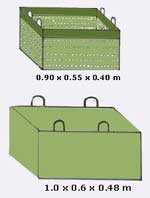|
19 September 2025
|
|
|
മലയാളം
|
|
|
|
|
|
Agriculture > Spices
> Turmeric (Curcuma longa)
|
|
|
|
Processing & Value Addition
Curing
Fresh turmeric is cured for obtaining dry turmeric. The fingers are separated
from mother rhizomes. Mother rhizomes are usually kept as seed material.
Curing involves boiling of fresh rhizomes in water and drying in the sun.
In the traditional method of curing, the cleaned rhizomes are boiled in water just
enough to immerse them. Boiling is stopped when froth comes out and white
fumes appear giving out a typical odour. The boiling should last for 45-60
minutes when the rhizomes become soft. The stage at which boiling is stopped
largely influences the colour and aroma of the final product. Over cooking
spoils the colour of the final product while under-cooking renders the dried product
brittle.
|
In the improved scientific method of curing, the cleaned fingers (approximately
50 kg) are taken in a perforated trough of 0.9 m x 0.5 m x 0.4 m size made of GI
or MS sheet with extended parallel handle. The perforated trough containing
the fingers are then immersed in a pan; 100 litres of water is poured into the trough
so as to immerse the turmeric fingers. The whole mass is boiled till the fingers
become soft. The cooked fingers are taken out of the pan by lifting the trough
and draining the water into the pan. The water used for boiling turmeric rhizomes
can be used for curing fresh samples. The processing of turmeric is to be
done 2 or 3 days after harvesting. If there is delay in processing, the rhizomes
should be stored under shade or covered with sawdust or coir dust.
Use turmeric boiler TNAU model 100 kg capacity especially
for commercial growers and steam boil for 60 minutes. This method reduces drying time
to 10 days and improve quality and cleanliness.
|

|
Drying
The cooked fingers are dried in the sun by spreading them in 5-7 cm thick layers
on bamboo mats or drying floor. A thinner layer is not desirable, as the colour
of the dried product may be adversely affected. During night time, the rhizomes
should be heaped or covered with material, which provides aeration. It may
take 10-15 days for the rhizomes to become completely dry. Artificial drying,
using cross-flow hot air at a maximum temperature of 60°C also gives a satisfactory
product. In the case of sliced turmeric, artificial drying has clear advantages
in giving a brighter coloured product than sun drying which tends to undergo surface
bleaching. The yield of the dry product varies from 10-30% depending upon
the variety and the location where the crop is grown.
Polishing

|
Dried turmeric has a poor appearance and a rough dull outer surface with scales
and root bits. The appearance is improved by smoothening and polishing the
outer surface by manual or mechanical rubbing. Manual polishing consists of
rubbing the dried turmeric fingers on a hard surface. The improved method
is by using a hand operated barrel or drum mounted on a central axis, the sides
of which are made of expanded metal mesh. When the drum filled with turmeric
is rotated, polishing is effected by abrasion of the surface against the mesh as
well as by mutual rubbing against each other as they roll inside the drum.
Turmeric is also polished in power-operated drums. The yield of polished turmeric
from the raw material varies from 15-25%.
|
Colouring
The colour of the processed turmeric influences the price of the produce.
For an attractive product, turmeric powder (mixed with little water) may be sprinkled
during the last phase of polishing.
|
|
|
|
Top
|
|
|
|
|
|